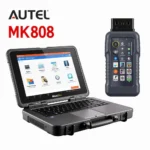Understanding how to properly hook up a scan tool to your 2000 Chevrolet S10 can seem daunting, but this guide will simplify the process. We’ll cover everything from locating the Diagnostic Link Connector (DLC) to interpreting those cryptic error codes.
Locating the DLC on Your 2000 S10
The first step is finding your truck’s DLC. In most 2000 S10 models, it’s located beneath the driver’s side of the dashboard, often near the steering column or the fuse box. This port, also known as the OBD-II port, is a standardized 16-pin connector.
Choosing the Right Scan Tool
Not all scan tools are created equal. Basic code readers can retrieve and clear engine codes, while advanced scan tools provide in-depth data, including live sensor readings and ABS information.
Consider these factors when selecting a scan tool:
- Functionality: Determine the level of detail you need. Do you want basic code reading or advanced diagnostics?
- Compatibility: Ensure the scan tool is compatible with your 2000 S10 and supports the OBD-II protocol.
- User-friendliness: Opt for a scan tool with a clear display, intuitive interface, and easy-to-understand instructions.
- Budget: Scan tools range in price from affordable basic models to professional-grade options.
Connecting the Scan Tool
With the DLC located and the right tool in hand, follow these steps to connect:
- Turn off the ignition.
- Insert the scan tool’s connector into the DLC. You should feel a secure connection.
- Turn the ignition key to the “on” position, but do not start the engine. This powers up the onboard computer and allows the scan tool to establish communication.
Reading and Understanding Error Codes
Once the connection is established, the scan tool will display any stored Diagnostic Trouble Codes (DTCs). These codes are standardized and provide clues about potential issues in your S10.
Example of a DTC:
- P0301: Cylinder 1 Misfire Detected
Decoding a DTC:
- First Character:
- “P” indicates a powertrain-related code.
- Second Character:
- “0” signifies a generic code applicable to all OBD-II compliant vehicles.
- Third Character:
- “3” points to the ignition system or misfire.
- Last Two Digits:
- “01” identifies the specific problem, in this case, a misfire in cylinder 1.
Important Note: Retrieving a code doesn’t pinpoint the exact cause of the problem. It’s essential to consult reliable repair manuals and potentially consult a qualified mechanic for accurate diagnosis and repair.
Clearing Error Codes
After addressing the underlying issue, you can use the scan tool to clear the DTC. However, keep in mind that simply clearing the code doesn’t fix the problem; it merely erases the code from the computer’s memory.
Beyond Basic Codes: Advanced Scan Tool Capabilities
Advanced scan tools offer a plethora of features beyond basic code reading and clearing. These features can be invaluable for DIY enthusiasts and professionals alike:
- Live Data Stream: Provides real-time information from various sensors, allowing you to monitor engine parameters, transmission performance, and more.
- Freeze Frame Data: Captures a snapshot of sensor readings at the time a fault code was triggered, offering valuable clues for diagnosing intermittent issues.
- Component Activation: Allows you to remotely activate components like fuel injectors, solenoids, and relays, aiding in pinpointing faulty parts.
- Adaptation and Reset Functions: Enables you to perform procedures like resetting the throttle position sensor or relearning transmission shift points.
Conclusion
Equipping yourself with the knowledge to connect and use a scan tool on your 2000 S10 puts you in control of your truck’s health. Remember, while a scan tool is a powerful diagnostic aid, it’s essential to pair its use with sound mechanical knowledge and reliable resources for accurate diagnosis and repair.
FAQs
1. Can I use any OBD-II scan tool on my 2000 S10?
While most 2000 S10 models are OBD-II compliant, confirming your specific model year is essential. Check your owner’s manual or look for the OBD-II compliance sticker under the hood.
2. What if my scan tool isn’t connecting to my truck?
Ensure the ignition is in the “on” position without the engine running. Check for a blown OBD-II fuse in the fuse box. If the problem persists, there might be an issue with the DLC itself or the scan tool.
3. Do I need a professional mechanic to use a scan tool?
No, scan tools are user-friendly, especially for basic code reading. However, interpreting codes and diagnosing problems often require mechanical expertise.
4. Can I damage my truck by using a scan tool incorrectly?
Using a scan tool properly is unlikely to cause damage. However, avoid disconnecting the scan tool while the ignition is on, and always double-check procedures in your repair manual before activating any components.
5. Where can I find more information about specific DTCs?
Reliable sources for DTC information include your vehicle’s repair manual, reputable online automotive forums, and the DiagXcar website.
Need Further Assistance?
Contact our team of experts at DiagXcar. We’re available 24/7 via WhatsApp: +1(641)206-8880, Email: cardiagtechworkshop@gmail.com. You can also visit us at 276 Reock St, City of Orange, NJ 07050, United States.



